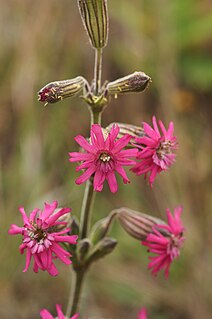Related Research Articles

Papaver rhoeas, with common names including common poppy, corn poppy, corn rose, field poppy, Flanders poppy, and red poppy, is an annual herbaceous species of flowering plant in the poppy family Papaveraceae. It is notable as an agricultural weed. Especially in the Commonwealth, it is used a symbol of remembrance of the fallen soldiers and other military, during World War I and thereafter.
This article gives an overview of the plant communities formed by vegetation of open habitats in the British National Vegetation Classification system.

Silene nutans is a flowering plant in the genus Silene, most commonly known as Nottingham catchfly.
British NVC community MG1, Arrhenatherum elatius grassland, is one of the mesotrophic grassland communities in the British National Vegetation Classification system. This type of plant community was named in 1919 as Arrhenatheretum elatiorisBr.-Bl.. It is a very widespread community throughout the British lowlands of England, Wales and southern and eastern Scotland.
British NVC community OV41 is one of the open habitat communities in the British National Vegetation Classification system. It is one of six communities of crevice, scree and spoil vegetation.
British NVC community OV39 is one of the open habitat communities in the British National Vegetation Classification system. It is one of six communities of crevice, scree and spoil vegetation.
British NVC community MC4 is one of the maritime cliff communities in the British National Vegetation Classification system. It is one of five communities categorised as maritime cliff crevice and ledge communities.

Silene gallica is a species of flowering plant in the family Caryophyllaceae known by several common names, including common catchfly, small-flowered catchfly, and windmill pink. It is native to Eurasia and North Africa, but it can be found throughout much of the temperate world as a common roadside weed.

Silene noctiflora is a species of flowering plant in the family Caryophyllaceae known by the common names night-flowering catchfly, nightflowering silene and clammy cockle. It is native to Eurasia, but it is known on other continents as an introduced species and sometimes a weed. In North America, it is a common weed of grain crops in the Canadian prairie provinces and in much of the United States. It grows in fields and in other disturbed habitat.

Silene scouleri is a species of flowering plant in the family Caryophyllaceae known by the common names simple campion and Scouler's catchfly.
British NVC community OV2 is one of the open habitat communities in the British National Vegetation Classification system. It is one of six arable weed and track-side communities of light, less-fertile acid soils.
British NVC community OV3 is one of the open habitat communities in the British National Vegetation Classification system. It is one of six arable weed and track-side communities of light, less-fertile acid soils.
British NVC community OV6 is one of the open habitat communities in the British National Vegetation Classification system. It is one of six arable weed and track-side communities of light, less-fertile acid soils.
British NVC community OV8 is one of the open habitat communities in the British National Vegetation Classification system. It is one of eight arable weed and wasteland communities of fertile loams and clays.
British NVC community OV15 is one of the open habitat communities in the British National Vegetation Classification system. It is one of two arable weed communities of light lime-rich soils.
British NVC community OV17 is one of the open habitat communities in the British National Vegetation Classification system. Although classed with communities OV15 and OV16 as an arable weed community of light lime-rich soils, it also shares many features with the communities classed as arable weed and wasteland communities of fertile loams and clays.
British NVC community OV25 is one of the open habitat communities in the British National Vegetation Classification system. It is one of four tall-herb weed communities.

Papaver dubium is a species of poppy known by the common names long-headed poppy and blindeyes. It is an annual species which prefers sandy soils without lime. It is widespread throughout its native Europe and as an introduction in America and elsewhere.

Silene regia is a species of flowering plant in the family Caryophyllaceae known by the common name royal catchfly. It is native to the central United States. A perennial herb, it grows from a fleshy taproot and has several erect stems growing up to 1.6 meters tall. The leaves are lance-shaped to oval and up to 12 centimeters long, becoming smaller farther up the stem. The inflorescence is an array of many flowers at the top of the stem. The elongate tubular calyx of sepals is up to 2.5 centimeters long and has 10 longitudinal veins. The lobes of the bright red corolla are 1 to 2 centimeters long.
Gentianella anglica, the early gentian, is a species of flowering plant in the genus Gentianella, native to Great Britain. Gentianella anglica is endemic to Great Britain and its centre of distribution is in Dorset, Wiltshire, and the Isle of Wight.
References
Rodwell, John S, ed. (March 2000). Maritime communities and vegetation of open habitats. British Plant Communities. Vol. 5. Cambridge University Press. ISBN 978-0-521-39167-2.
Wasscher, J (1941). "De graanonkruidassociates in Groningen en Noord-Drente". Nederlandsch Kruidkundig Archief. Utrecht: Nederlandsche Botanische Vereeniging. 51: 435–941.